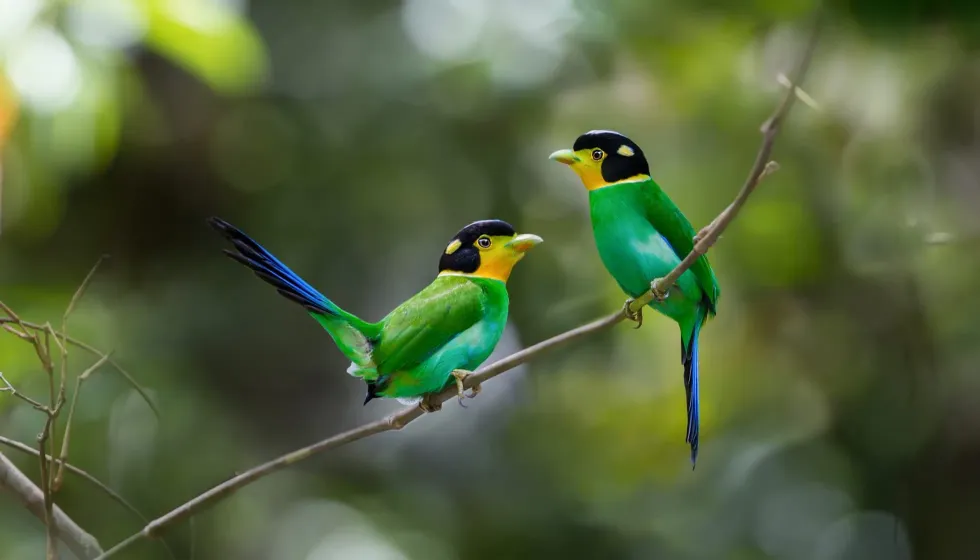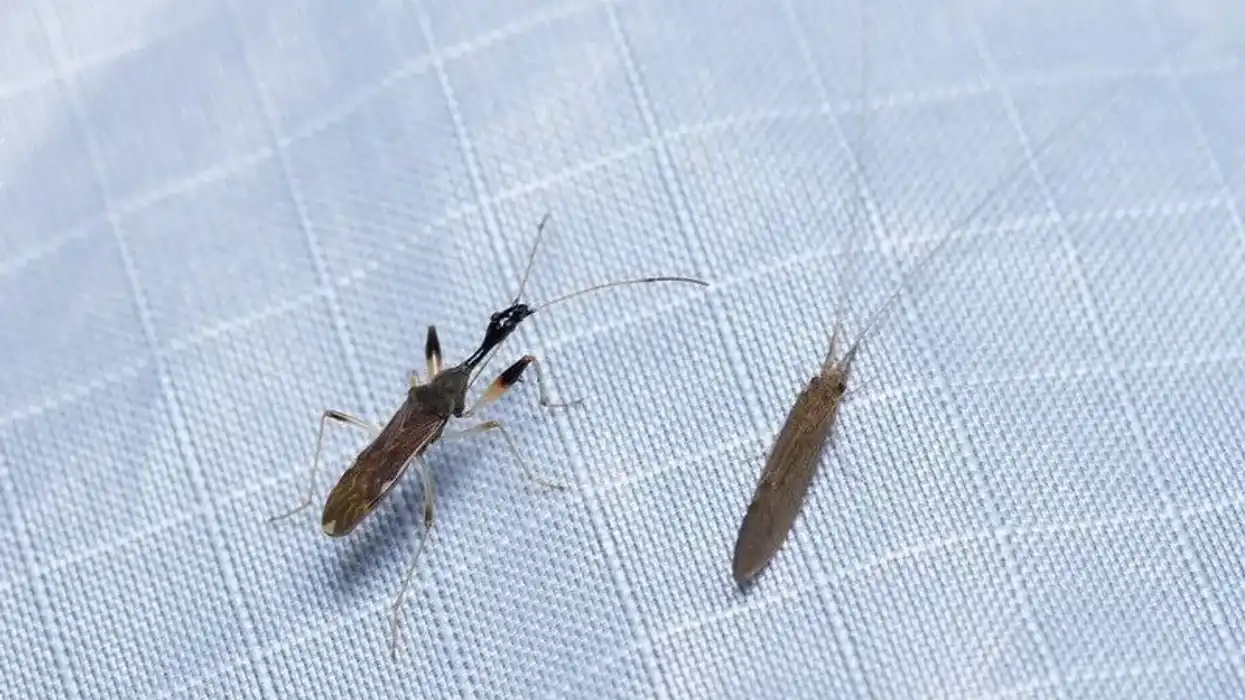Every child loves colors, and that's what makes the long-tailed broadbill (Psarisomus dalhousiae) the best bird to learn about! This colorful bird with its bright blue tail and green plumage will capture any child's attention and open their eyes to a world full of feathered friends.
This blue-tailed broadbill species is the only bird in its genus Psarisomus.
The term 'broadbill' refers to its distinctive flat, broad beak, and 'long-tail' refers to its blue tail, which is longer than its body. The long-tailed broadbill range map shows that the Psarisomus dalhousiae is a species that is found in the Himalayan mountain range, Northeastern India and Southeast Asia.
The long-tailed broadbill's call is a loud and shrill song that makes identifying this bird species easy. Their main predators are larger birds and bird-eating animals like weasels.
They travel in noisy flocks and forage in a group of about 10-15 birds. The females lay five to six eggs, and the birds build large pear-shaped nests from the branches of tall trees.
The young ones leave the nest and settle elsewhere in the habitat range once they grow up.
This bird species has five recognized subspecies in the world. If you want to learn more about birds, check out birds like Sanderling and Brant!
Long-Tailed Broadbill Interesting Facts
What type of animal is a long-tailed broadbill?
It is a colorful bird with a distinctive shrill long-tailed broadbill song.
What class of animal does a long-tailed broadbill belong to?
It is a bird species, with a helmet-like coloring on its black and yellow head, belonging to the order Passeriformes, family Eurylaimidae, and genus Psarisomus. Psarisomus dalhousiae is a species named by Jameson (1835).
How many long-tailed broadbills are there in the world?
The adult long-tailed broadbill (Psarisomus dalhousiae) has been classified as Least Concern and is a reasonably common species in the forests and is protected in the National Parks of Southeast Asian countries. It will not need any help in conservation if the current population numbers continue.
Where does a long-tailed broadbill live?
These blue-tailed birds are seen in tropical evergreen forests at an altitude range of 500-8200 ft (150-2500 m). The long-tailed broadbill (Psarisomus dalhousiae) is a free species that call the forests and wetlands of the Himalayan Range in India, Vietnam, Thailand, Borneo, and Malaysia. The long-tailed broadbill (Psarisomus dalhousiae) is a non-migratory species.
What is a long-tailed broadbill's habitat?
The long-tailed broadbill (Psarisomus dalhousiae) of the genus Psarisomus lives at the top of the Himalayas and usually resettle at a lower altitude during the colder months. The long-tailed broadbill (Psarisomus dalhousiae) typically prefers to live in a forest close to a small water body.
Who does a long-tailed broadbill live with?
Long-tailed broadbill (Psarisomus dalhousiae) are social birds that travel and forage as a noisy group (10-15 in number). Their flocks have also been found to be of mixed species. They are shy birds that prefer to live in the higher branches of trees.
How long does a long-tailed broadbill live?
The long-tailed broadbill (Psarisomus dalhousiae), a distinctly blue-tailed bird, has a generation length of 4.2 years in its natural forest habitat. Its lifespan is on the lower side like most small birds like the Vesper sparrow.
How do they reproduce?
The long-tailed Broadbill (Psarisomus dalhousiae) has variations in its breeding season depending on the geographical location, but it usually begins in March or April.
The long-tailed broadbill (Psarisomus dalhousiae) females lay five to six eggs, and adults of both sexes of long-tailed broadbills of the family incubate and feed the young—they nest in a large pear-shaped nest from the high branches of tall trees.
There are also some signs that these broadbills are cooperative breeders.
What is their conservation status?
The long-tailed broadbill (Psarisomus dalhousiae) has been categorized as Least Concern in the ICUN Red List. They are commonly seen free in South Asian and Southeast Asian territories like the Himalayas (India), Malaysia, Vietnam, Thailand, and Borneo.
Long-Tailed Broadbill Fun Facts
What does a long-tailed broadbill look like?
The description of an adult long-tailed broadbill (Psarisomus dalhousiae) may be encompassed in a single word; colorful. They have a bright yellow ring around their neck and a face of the same hue. Their back and yellow head rest on a green-colored body and wings, which is in contrast to the unique blue tail.
How cute are they?
The long-tailed broadbill (Psarisomus dalhousiae) is a species of the order Passeriformes and may very well be the cutest bird you've seen. Their colorful plumes make for a breathtaking view when you enter their forest.
Although, this bird species may need some help from the media to increase its popularity in the world outside their native countries (India, Vietnam, Thailand, and Borneo).
How do they communicate?
Calling their call a loud, high-pitched descending whistle song is the perfect long-tailed broadbill call description.
How big is a long-tailed broadbill?
An adult long-tailed broadbill (Psarisomus dalhousiae) is 10 in (25 cm) in height. The long-tailed broadbill size is around two times that of a sparrow and less than half the size of a Black Hawk Eagle.
How fast can a long-tailed broadbill fly?
Since the long-tailed broadbill (Psarisomus dalhousiae) is a wild bird, they fly faster than most garden variety birds. Their small size can also help the bird fly fast.
How much does a long-tailed broadbill weigh?
The long-tailed broadbill (Psarisomus dalhousiae) of the order Passeriformes is very light and weighs 1.7-2.1 oz (50-60 g).
What are the male and female names of the species?
There are no specific names to differentiate between the adult male and female birds of long-tailed broadbill (Psarisomus dalhousiae). But, this bird species, P. dalhousiae of genus Psarisomus, has five recognized subspecies in the world, which are: P. d. dalhousiae, P. d. cyanicauda, P. d. divinus, P. d. psittacinus, and P. d. borneensis.
What would you call a baby long-tailed broadbill?
There is no specific name for a baby long-tailed broadbill (Psarisomus dalhousiae), but its identification is easy. Long-tailed broadbill (Psarisomus dalhousiae) juveniles have a short blue tail, with a duller hue of green, black, and yellow head and body compared to the adult.
What do they eat?
The long-tailed broadbill (Psarisomus dalhousiae) is an insectivore that usually preys on small insects like grasshoppers, flies, bugs, and beetles. They may also eat small frogs and berries.
Are they poisonous?
No, long-tailed broadbill (Psarisomus dalhousiae) birds are not poisonous.
Would they make a good pet?
Long-tailed broadbill (Psarisomus dalhousiae) birds have a medium dependence on forests and like to nest 500-8200 ft (150-2500 m) high. These specific requirements regarding habitat make it best to leave the bird to live freely in nature.
Did you know...
The long-tailed broadbill (Psarisomus dalhousiae) is one of the few bird species which forages and travels in flocks of mixed species.
The long-tailed broadbill (Psarisomus dalhousiae) is a part of three percent of the bird species in the world that practice cooperative breeding, where two to three birds of the same species provide care in rearing the babies. The Scrub Jay is another cooperative breeder.
The scientific name of the long-tailed broadbill, Psarisomus dalhousiae, commemorated the Countess of Dalhousie and was authored by Jameson(1835).
The Indian Peafowl, the national bird of India, is a vibrantly colored bird with the longest tail in India.
What's unique about the long-tailed broadbill?
This bird has a high-pitched descending whistle tone call which sounds like 'pseeu...pseeu...pseeu' and 'tseeay...tseeay', which, coupled with their flamboyant plumage, makes them unique ad easy to identify.
Is the long-tailed broadbill endangered?
The long-tailed broadbill (Psarisomus dalhousiae) isn't endangered yet; it is classified as Least Concern in the ICUN Red List. But, it is suspected that this long-tailed broadbill (Psarisomus dalhousiae) species population is declining in the world and is already extinct in Bangladesh. This decline is due to habitat fragmentation and the destruction of the native forest.
Here at Kidadl, we have carefully created lots of interesting family-friendly animal facts for everyone to discover! Learn more about some other birds from our Carmine Bee-Eater facts and Nightingale facts pages.
You can even occupy yourself at home by coloring in one of our free printable long-tailed Broadbill coloring pages.










